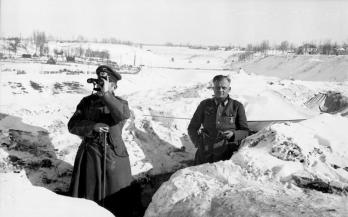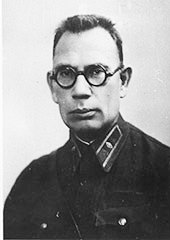Dizzy from the relative successes of the 1941 winter counteroffensive, the Red Army high command drew up ambitious plans for early 1942 to lift the German siege of Leningrad by disrupting the communications of Army Group North. Other than saving those starving civilians trapped in the city since its encirclement, Leningrad was also an important industrial and armaments center for the Soviet Union, and a valuable economic target. The harsh winter of the previous year had frozen Lake Ladoga, aiding in evacuation efforts, but a land route to the city was still the preferred option. Accordingly, great attention was paid by Soviet planners to breaking the German “iron ring” around the city, even if the Red Army lacked the resources to achieve that goal. The chief of the artillery administration had to fly in personally with an airplane full of artillery gun sights because the newly produced Soviet artillery pieces had none.
 The Lyuban Offensive Operation involved the Volkhov Front (named for the city of Volkhov 76 miles east of Leningrad) under Kirill Meretskov and the Leningrad Front under Mikhail Khozin. Most of the subsequent battles ended up taking place in the dense forests and murky swamplands along the Volkhov River in and around the town of Lyuban 53 miles southeast of Leningrad. Much of the area belonged to the drainage basin of the Neva River and was rough, impassable terrain. The local railway, however, was of strategic importance because it connected Leningrad to the major cities of Moscow and Novgorod to the south. Even though Soviet rail gauges were different from those of central Europe, access to rare functional infrastructure was valued by both sides.
The Lyuban Offensive Operation involved the Volkhov Front (named for the city of Volkhov 76 miles east of Leningrad) under Kirill Meretskov and the Leningrad Front under Mikhail Khozin. Most of the subsequent battles ended up taking place in the dense forests and murky swamplands along the Volkhov River in and around the town of Lyuban 53 miles southeast of Leningrad. Much of the area belonged to the drainage basin of the Neva River and was rough, impassable terrain. The local railway, however, was of strategic importance because it connected Leningrad to the major cities of Moscow and Novgorod to the south. Even though Soviet rail gauges were different from those of central Europe, access to rare functional infrastructure was valued by both sides.
In the face of Soviet counterattacks, Hitler had ordered the Wehrmacht to stand-fast and not give up an inch of captured territory. Army Group North under Wilhelm Ritter von Leeb had originally anticipated the swift capture of Leningrad after overcoming stiff resistance in Russia after conquering the Baltic region. During the German assault on Moscow in late 1941, however, Third Panzer Group had been transferred from Leeb’s command to Army Group Center, forcing Leeb to take objectives like Pskov and Novgorod with less armor support. By December and January, the German forces were reeling from consistent Soviet attacks. Desperate for freedom to redeploy, von Leeb delivered an ultimatum to Hitler on January 15 demanding greater field autonomy. Hitler expected his commanders to follow his will absolutely, and so he relieved Leeb of command and appointed Georg von Küchler, commander of the German 18th Army, as his replacement. Küchler, a fierce anti-Semite and Hitler supporter, had overseen the murder of mentally disabled people during Operation Barbarossa. Under his direction, the German defenders held and executed a defensive pincer in March, trapping Soviet forces. Just like the civilians within Leningrad, the Soviet units were totally surrounded.
One of these units was the Soviet 2nd Shock Army, a unit formed from the remnants of the 26th Army, which itself had been rebuilt three times during Operation Barbarossa. It had broken through German lines early on but had its own supplies cut and was encircled. The unit took to the rough marshes to await a breakout. In April Andrei Vlasov took command of the 2nd Shock Army with the mission to extricate it. He had risen to prominence during the December Moscow counteroffensive. He lacked, however, the adequate weapons and officers to affect an escape. The Soviets could tie down the Germans, but not establish a breakthrough. As the winter gave way to spring, the German pincer tightened, completely closing in June. Around 60,000 Soviet soldiers were either killed or captured. Among those taken prisoner was Vlasov.
 Vlasov would later defect to Nazi Germany while in captivity and would become commander of the Russian Liberation Army, a collaborationist unit consisting of Soviet POWs and White Russian émigrés. The German government never fully trusted the unit, preferring to use it for propaganda purposes rather than in a combat role. Not only were the loyalties of many of its members to Germany suspect, but Nazi belief held that all Slavs were inferior and even inhuman creatures. As Germany became desperate toward the end of the war, the ROA was finally deployed for action in 1944, only to opportunistically turn against their German commanders during the Czech uprising in Prague. Seeking to escape punishment as traitors, the army attempted to surrender to Allied forces, but they were turned over to Soviet authorities. Vlasov and other leading officers were later executed.
Vlasov would later defect to Nazi Germany while in captivity and would become commander of the Russian Liberation Army, a collaborationist unit consisting of Soviet POWs and White Russian émigrés. The German government never fully trusted the unit, preferring to use it for propaganda purposes rather than in a combat role. Not only were the loyalties of many of its members to Germany suspect, but Nazi belief held that all Slavs were inferior and even inhuman creatures. As Germany became desperate toward the end of the war, the ROA was finally deployed for action in 1944, only to opportunistically turn against their German commanders during the Czech uprising in Prague. Seeking to escape punishment as traitors, the army attempted to surrender to Allied forces, but they were turned over to Soviet authorities. Vlasov and other leading officers were later executed.
The loss of the 2nd Shock Army was a bitter reminder of Barbarossa, when losing entire armies to the German blitzkrieg had become a devastating, humiliating reality. Six infantry divisions and six brigades were destroyed, another nine divisions partly. In the first six months of 1942 a total of 20 Soviet divisions would be ultimately wasted in futile attempts to end the Leningrad siege, mirroring similar failed operations across the Eastern Front. In Leningrad itself, the three months between January to March would be the worst of the siege, with near-constant artillery bombardment coupled with scarce food and fuel. Despite this, the city would not surrender, secure in the knowledge that Germany’s genocidal policies in the Nazi-Soviet war nullified any chance of mercy.
Sources
Bellamy, Chris. 2007. Absolute War: Soviet Russia in the Second World War. New York: Alfred A. Knopf.
Fritz, Stephen. 2015. Ostkrieg: Hitler’s War of Extermination in the East. Lexington, KY: University of Kentucky Press.
Glantz, David and Jonathan House. 1995. When Titans Clashed: How the Red Army Stopped Hitler. Lawrence, KS: University of Kansas Press.